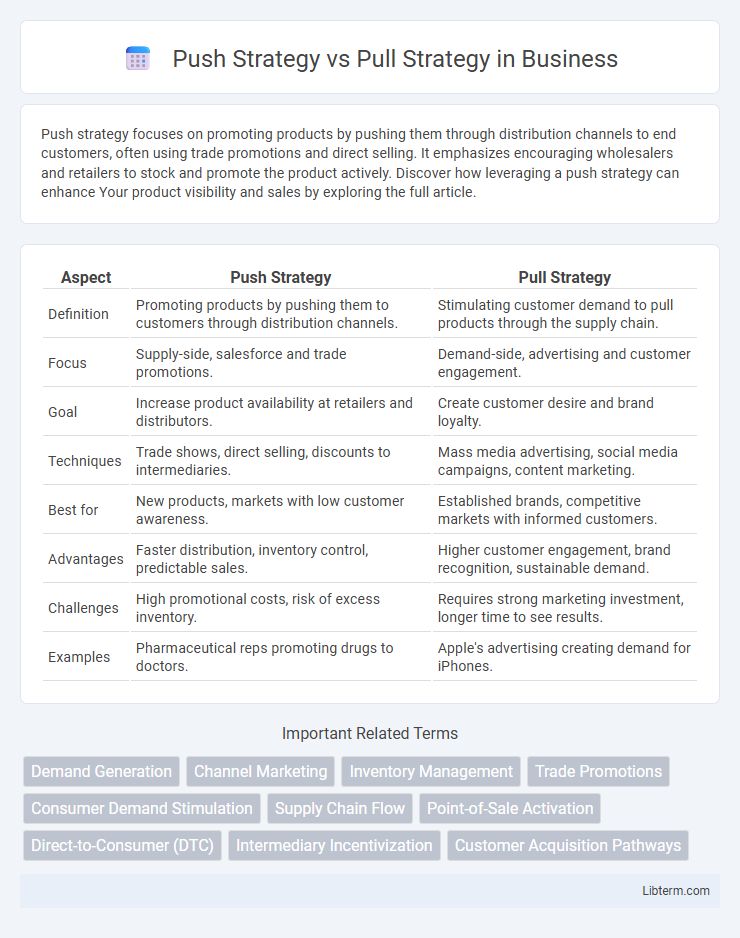Push strategy focuses on promoting products by pushing them through distribution channels to end customers, often using trade promotions and direct selling. It emphasizes encouraging wholesalers and retailers to stock and promote the product actively. Discover how leveraging a push strategy can enhance Your product visibility and sales by exploring the full article.
Table of Comparison
| Aspect | Push Strategy | Pull Strategy |
|---|---|---|
| Definition | Promoting products by pushing them to customers through distribution channels. | Stimulating customer demand to pull products through the supply chain. |
| Focus | Supply-side, salesforce and trade promotions. | Demand-side, advertising and customer engagement. |
| Goal | Increase product availability at retailers and distributors. | Create customer desire and brand loyalty. |
| Techniques | Trade shows, direct selling, discounts to intermediaries. | Mass media advertising, social media campaigns, content marketing. |
| Best for | New products, markets with low customer awareness. | Established brands, competitive markets with informed customers. |
| Advantages | Faster distribution, inventory control, predictable sales. | Higher customer engagement, brand recognition, sustainable demand. |
| Challenges | High promotional costs, risk of excess inventory. | Requires strong marketing investment, longer time to see results. |
| Examples | Pharmaceutical reps promoting drugs to doctors. | Apple's advertising creating demand for iPhones. |
Introduction to Push and Pull Strategies
Push strategy involves promoting products by pushing them through marketing channels to reach consumers directly, often using tactics like trade shows, direct selling, and point-of-sale displays. Pull strategy creates consumer demand by encouraging buyers to actively seek out a product, typically through advertising, social media campaigns, and content marketing. Both strategies aim to increase product awareness and sales but differ in their approach to influencing customer behavior and channel dynamics.
Defining Push Strategy in Marketing
Push strategy in marketing involves promoting products by pushing them onto consumers through channels such as wholesalers, retailers, or sales teams. It emphasizes direct selling and trade promotion to increase product visibility and availability in the market. This approach is effective in driving short-term sales and managing inventory by ensuring products reach the end consumer quickly.
Defining Pull Strategy in Marketing
Pull strategy in marketing focuses on creating consumer demand to attract customers to products or services through targeted communication and promotional efforts. This approach leverages techniques such as content marketing, social media engagement, and search engine optimization to generate interest and encourage consumers to actively seek out the brand. By fostering brand loyalty and direct interaction, pull strategy builds a sustainable customer base that drives organic sales growth.
Key Differences Between Push and Pull Strategies
Push strategy emphasizes proactively promoting products through channels such as wholesalers and retailers to drive demand, while pull strategy focuses on creating consumer demand through advertising and direct engagement to encourage customers to seek out the product. Push relies on supply chain management and sales force efforts, whereas pull depends on brand loyalty and customer-driven demand generation. Key differences include control over customer demand, marketing approach, and the targeted stage of the purchasing process.
Advantages of Push Strategy
Push strategy effectively ensures product availability by driving inventory directly to retailers, increasing immediate market presence and accelerating sales cycles. This approach enhances control over distribution channels, allowing businesses to manage stock levels and promotional efforts efficiently. It also facilitates faster introduction of new products by leveraging existing partnerships and trade incentives to stimulate retailer demand.
Advantages of Pull Strategy
The Pull Strategy enhances customer engagement by encouraging demand through targeted marketing efforts and personalized content, resulting in higher brand loyalty and repeat purchases. It allows companies to gather valuable consumer data, enabling tailored promotions and improved product development. Moreover, the Pull Strategy reduces inventory costs by producing goods based on actual customer demand rather than speculative forecasts.
When to Use Push Strategy
Push strategy is most effective when launching new products or entering untapped markets, as it actively promotes items through distribution channels to create immediate demand. Businesses leverage push tactics when quick inventory turnover is essential, especially in industries with short product life cycles like technology or fashion. It works well in scenarios with established supply chains and trusted retailer relationships, ensuring product availability and visibility at the point of sale.
When to Use Pull Strategy
Pull strategy is most effective when targeting customers who are already aware of their needs and actively seek specific products, such as in technology or fashion markets driven by brand loyalty. It works well in competitive industries where building strong customer relationships and brand preference leads to repeat purchases and long-term engagement. Companies should use a pull strategy when aiming to create demand through advertising, content marketing, and social media campaigns that attract and engage consumers directly.
Real-World Examples of Push vs Pull Strategies
Push strategy in marketing involves proactively promoting products to retailers or customers, exemplified by companies like Procter & Gamble using extensive trade promotions to stock products on shelves. Pull strategy creates consumer demand to draw products through the distribution channel, as seen with Apple's brand loyalty and advertising driving customers to stores for iPhones. Fast-moving consumer goods often use push techniques, while technology brands rely more on pull marketing to generate consumer interest and demand.
Choosing the Right Strategy for Your Business
Choosing the right strategy for your business depends on customer behavior, product type, and market dynamics. A push strategy emphasizes proactive promotion through channels like trade shows and direct sales, ideal for new products aiming for rapid market penetration. Conversely, a pull strategy leverages customer demand through advertising and content marketing, effective for established brands seeking long-term loyalty and engagement.
Push Strategy Infographic

 libterm.com
libterm.com